Case File #009: The Green Children of Woolpit – A Medieval Mystery Beyond Explanation
Status: Historical Anomaly – Unverified Accounts
Date Filed: Circa 12th Century (c. 1150–1170 AD)
Last Reviewed: May 31, 2025
Location: Woolpit Village, Suffolk, England
Subjects: Unknown Male & Female Children – “Green-Skinned”
Filed Under: Historical Mystery – Possible Folklore or Dimensional Displacement
Access Level: Archival – Interdisciplinary Review Ongoing
Introduction: When the Forest Opened a Door
Deep within the rural folds of 12th-century Suffolk, England, in the tiny village of Woolpit, an event occurred that has baffled historians, folklorists, and paranormal theorists for centuries. Two children—brother and sister—were discovered near a wolf pit (from which the village gets its name), their skin tinted an unearthly green. They spoke no known language, wore clothing of strange material, and seemed terrified by their surroundings.
Though one child died soon after their discovery, the other survived, adapted, and eventually offered a haunting account: they came from a place called “St Martin’s Land,” a world with no sun, only twilight, and where everyone was green.
Over 800 years later, the story of the Green Children of Woolpit remains one of the strangest mysteries in recorded medieval history—floating between folklore, historical fact, and something far more unsettling.
Discovery: A Strange Sight in the Fields
According to two independent historical accounts—by Ralph of Coggeshall and William of Newburgh—two young children appeared suddenly in the fields outside Woolpit, sometime during the reign of King Stephen or King Henry II (roughly 1150–1170 AD). The children were found by reapers harvesting crops near one of the area’s wolf traps.
They were disoriented, speaking in an unknown tongue. Most striking of all: their skin was green—a vibrant, plant-like hue.
The villagers brought the children into Woolpit, where they were taken in by the local landowner, Sir Richard de Calne.
Behavior and Adaptation
The children were distressed and refused to eat any food offered to them for several days. They eventually accepted raw broad beans, eating them eagerly and almost exclusively for some time.
Their clothes were described as being made of unfamiliar fabric and strange design, and they were believed to be siblings, with the boy being younger.
Tragically, the boy grew ill and died shortly after baptism—some say from shock, others from the change in diet or stress. The girl, however, adjusted over time, began eating regular food, and slowly lost the green hue from her skin.
She learned to speak fluent English and would go on to live a relatively normal life—eventually serving in the household of Sir Richard de Calne and even reportedly marrying a man from King’s Lynn.
The Girl’s Story: “We Came from the Land of St. Martin”
Once the girl had learned English, she revealed a chilling origin story.
She and her brother came from a place called “St Martin’s Land,” a subterranean or parallel world where there was no sun—only perpetual twilight. Everyone in that land, she said, had green skin like theirs. One day, while herding their father’s cattle, the two children wandered into a cavern. After walking in darkness for a long time, they were suddenly blinded by bright light and loud noise—emerging in Woolpit.
She claimed they became disoriented, lost, and tried to return home but could not find the passage again.
There was no explanation for how they crossed into the world of Woolpit—or why it appeared so different from their own.
Analysis and Theories
The story has fascinated scholars for centuries. Even the most skeptical historians admit that the consistency across two medieval sources—both written by reputable monks—suggests the tale may not be entirely fictional.
Here are the leading theories:
1. Underground or Isolated Refugees
Some believe the children may have been Flemish orphans fleeing war in nearby regions. The green skin could be attributed to hypochromic anemia, also known as “green sickness,” caused by malnutrition. However, this does not explain their language or their utter confusion at the world around them.
2. Psychological Folklore
Another theory is that the entire tale is a folk allegory, possibly created to explain differences in skin tone, language, or cultural isolation. However, the level of detail—clothing, diet, speech, and the girl’s coherent testimony—complicates this theory.
3. Parallel Dimension or Interdimensional Portal
The most speculative theory suggests that the children came from a parallel world or dimension. The cave they described may have been a physical or metaphysical portal. The mention of "no sun," the unusual vegetation, and the existence of a sunless world mirror descriptions in modern accounts of interdimensional travel.
4. Extraterrestrial Origin
Some researchers draw connections between this case and UFO lore. Could the children have been part of an alien experiment or accident? The green skin, strange language, and rapid decline in one child’s health upon entering Earth’s environment align with some accounts of off-world beings unable to adjust to human biology.
Cultural Legacy
The Green Children have lived on in countless books, songs, academic studies, and folklore retellings. In recent years, the story has been revisited through the lenses of speculative physics, paranormal investigation, and even genetic memory.
Some modern paranormal theorists place this case alongside others like the Man from Taured, the Pollock Twins, and the Dyatlov Pass incident—events that hint at fractures in our perceived reality.
Woolpit itself still embraces the legend. Signs in the village bear the green children's imagery, and the wolf pit fields where they were found remain untouched by modern development—a strange nod to the village’s brush with the inexplicable.
Conclusion: Fact, Folklore, or Fracture in Reality?
The tale of the Green Children of Woolpit occupies a unique space in historical mystery. It is too old to verify, too strange to dismiss, and too detailed to forget. Whether it was a misunderstood refugee case, an allegorical myth, or a genuine breach of dimensional boundaries, we may never know the full truth.
What we do know is that one green-skinned girl, long dead, once told a tale of a sunless world beneath or beyond our own—and history has never been the same.
References
All sources used in this case are listed in the References Archive. Each link corresponds to verified data, public records, or expert documentation.

